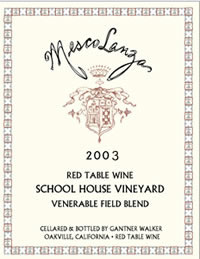|
|

theCompass mobile application is a winery, brewery, and distillery locator for North America. |
|
|
School House Vineyard

|
|
The School House Vineyard is nestled among the cool, lush forested slopes of Spring Mountain above St. Helena, where Langtry and Spring Mountain Roads intersect, at an elevation of approximately 1500 feet. The vineyard takes its name from the 1890s one-room school house which graced the property until it was consumed by fire in the mid 1980s. The School House has lent its name to this fascinating and unique vineyard property which has quietly produced very small quantities of some of the most sought after Napa Valley wines since the mid-1950s. Steeped in Napa Valley history, School House is the ultimate cult wine producer, cult before cult was cool!
|
|
|
Directions
From Napa, Take Hwy 29 North 17.2 miles to St. Helena
Third traffic light in St. Helena is Madrona. Turn left onto Madrona. Third right is Spring Mountain Rd towards Santa Rosa. Turn right onto Spring Mountain. Go 3.6 miles and turn left onto Langtry Rd. You see the vines on your left. Vineyard is first left off of Langtry. From Downtown Santa Rosa, Take 4th street easterly 2.4 miles. 4th turns into Sanoma Hwy 12 East towards Sanoma. After 2.6 more miles, turn left onto Calistoga Road. Go 3.4 miles over big grade and down other side. Turn right onto St. Helena Road. Go 6.7 Miles to Napa county line. Road name changes to Spring Mountain Rd. Go 1.6 more miles. Turn very sharp right onto Langtry Rd. You see the vines on your left. Vineyard is first left off of Langtry.
View Map
|
View Weather
Mescolanza
Mescolanza is a Spanish word for "medeley". This venerable—some of the vines are well over 100 years old—mixed black field-blend derives its character from mountain-grown Zinfandel (76%), Petite Sirah (17%) and Carignane (7%) varieties. The unirrigated vineyard block bears a fraction of the amount of fruit which its irrigated cousins produce. Thus the elegant, spicy wine from this fruit is more intense and concentrated. It is a ‘big’ wine with balanced acidity which makes a robust wine that is a perfect paring with rich, well-flavored foods. This 2003 Mescolanza was fermented in open bins and matured through its secondary malolactic fermentation in older, seasoned barrels providing an ever so subtle kiss of oak.
We have chosen to show the Vallejo Family Crest on the Mescolanza label, because John is the great great grandson of Salvador Vallejo, the first European resident of the Napa Valley. John cautions, "Excessive consumption of this wine may cause Zinfomania".
.
|
School House Chardonnay
This Burgundian style Chardonnay comes from the terraced area of our School House Vineyard. The Chardonnay, like our Pinot Noir and Mescolanza is dry-farmed (not irrigated). The vines were propagated from the Wente "small berry clone" which came to us originally from Stony Hill Vineyard.
This 2004 Chardonnay is an excellent example of our elegant, clean wine and is unlike most California Chardonnays. The press was applied immediately following harvest, and the resulting 'must' was carried to seasoned French oak barrels to ferment and age for about 14 months. When the wine was 'ready' it was hand-bottled. It is not filtered. Two barrels were produced.
|
School House Pinot Noir
Since the first vintage of School House Pinot Noir was produced in1957, our feminine, Burgundian style wine has proved that the combination of the 1500 foot vineyard elevation, the cooler microclimate of the School House Vineyard, our fertile and well drained mountain soils, along with our decision to continue dry-farming (not irrigating) the vineyards combines to provide ideal growing conditions for the evolution of these noble Pinot Noir vines. This small crop (just under a ton per acre) was fermented in open-top bins after a light pressing to separate the stems from the fruit. The dry, young wine matured in new French Oak cooperage, and after 18 months was hand-bottled.
|
Add New Review
|
|